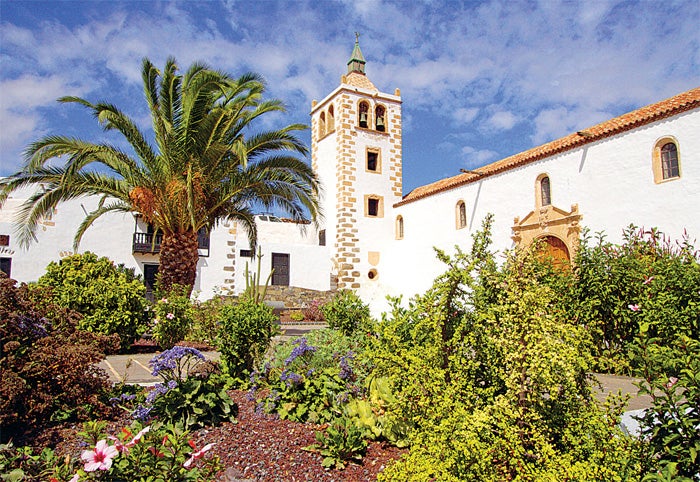The beautiful land of Fuerteventura
Away from the beaches are the colonial mansions and rustic charm

It’s a warm autumn morning and a donkey is eyeing up my elevenses. Its owner notices at once, and tells it to behave. They’re on duty, after all. Both are traditionally dressed – the man in a waistcoat and trilby, the donkey in a burlap yoke – and they’re here to drive the community waterwheel.
I’m in Pájara, a quiet village in the foothills of Fuerteventura’s central highlands. Here, water has always been a precious, hard-won commodity. Irrigation used to keep the island’s terraced hillsides green, but deforestation and over-grazing by goats have long since left them a semi-desert. As soon as the opportunity arose, many islanders abandoned farming and turned to tourism instead.
Until relatively recently, they’ve focused their attentions on the coast. This is understandable, since Fuerteventura does beaches very well. It has soft ones to bury your toes in, breezy ones for watersports and secluded ones for skinny-dipping. Ask a random sample of tourists to name their favourite spot on the island and chances are every single reply will begin with ‘playa’.
However, over the last few years rural islanders have begun to offer an alternative. Pájara’s traditional-style waterwheel, installed by the village council, is a stop on its Ethnography Trail, just one of several nature and culture circuits designed to introduce tourists to life beyond the beach. Strolling around Pájara, you can call in at the old tannery, visit the bakery or admire the unusual church portico, decorated with Aztec-like carvings. Elsewhere, there are colonial mansions to admire, social history museums to investigate and wilderness regions to explore.
Visitors who are fit enough to handle merciless inclines can build a visit to the rugged highlands into a cycling tour of the island, or pick a base from which to plot their own hiking routes.
I’ve decided to explore by car. From Pájara, I drive through a region of long-dead volcanoes and ancient, weathered lava fields, my windscreen framing a striking panorama of terracotta, russet and beige. Road signs warn of leaping goats, but lichens and euphorbias are the only living things I can see. It’s only when I stop |the car and step out that I really register the subtle power of this strange landscape. There’s an |immense, silent beauty to it.
In the placid valley town of Antigua, I make a discovery: Fuerteventura’s traditional windmills are distinguished by gender. Female windmills – molinas – are one storey high, while male windmills – molinos – are generally two storeys. Built of timber and stone, with canvas sails, their purpose was to grind toasted maize into gofio, the Canarian staple. After goats, windmills are the island’s favourite motif, etched into ceramics and woven into lace.
In the garden of the Molino de Antigua, a well-kept rural museum, there’s a fine example of a 200-year-old molino, restored to full working order. Mentally donning a smock, I climb inside to inhale the woody smell of rustic flour.
By the time I reach Betancuria, a 600-year-old village in the highlands, an afternoon hush has settled. Cradled by ochre-coloured hills, this picturesque jumble of whitewashed houses was once the Fuerteventuran capital. Remembering its grandiose past, the parish church of Santa Maria still calls itself a cathedral and guards a hoard of priceless statues.
Spotting the sign for Casa Señores Saavedra above a worn stone doorway, I duck inside. The bar is small and cool, with whitewashed walls and stone benches. A pair of timples (musical instruments similar to lutes) hang overhead. The owner’s niece mixes me the house special – orange juice with pomelo, lemonade and grenadine – and offers to show me around while lunch is prepared.
Explaining that the house has been in her family since the time of the conquest in the early 1400s, she leads me out to a sun-dappled patio draped with bougainvillea. Little by little, her clan has been restoring the place, taking care to preserve its historic narrative: the original kitchen still has its wood-fired ranges. It’s a delightful discovery in a gem of a village – and my lunch, roasted goat from those ochre-coloured hills, is delicious.
* Molino de Antigua, near Antigua |(00 34 928 878 041). Open Tues-Sat, 10am-6pm. Admission €1.80.
* Casa Señores Saavedra, Betancuria (00 34 928 878 979; princessarminda.com). Open daily, noon-5pm.
Join our commenting forum
Join thought-provoking conversations, follow other Independent readers and see their replies
Comments